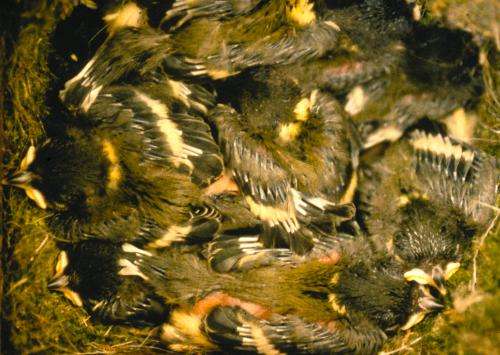Climate change disrupts songbird's timing without impacting population size (yet)

Songbird populations can handle far more disrupting climate change than expected. Density-dependent processes are buying them time for their battle. But without (slow) evolutionary rescue it will not save them in the end, says an international team of scientists led by the Netherlands Institute of Ecology (NIOO-KNAW) in Science this week.
Yes, spring started late this year in North-western Europe. But the general trend of the four last decades is still a rapidly advancing spring. The seasonal timing of trees and insects advance too, but songbirds like Parus major, or the great tit, lag behind. Yet without an accompanying decline in population numbers, it seems, as the international research team shows for the great tit population in the Dutch National Park the Hoge Veluwe.
"It's a real paradox," explain Dr Tom Reed and Prof Marcel Visser of the Netherlands Institute of Ecology. "Due to the changing climate of the past decades the egg laying dates of Parus major have become increasingly mismatched with the timing of the main food source for its chicks: caterpillars. The seasonal timing of the food peak has advanced over twice as fast as that of the birds and the reproductive output is reduced. Still, the population numbers do not go down." On the short term, that is, as Reed, Visser and colleagues from Norway, the USA, and France have now calculated using almost 40 years of data from this songbird.
The solution to the paradox is that although fewer offspring now fledge due to food shortage, each of these chicks has a higher chance of survival until the next breeding season. "We call this relaxed competition, as there are fewer fledglings to compete with," first author Reed points out. Out of 10 eggs laid, 9 chicks are born, 7 fledge and on average only one chick survives winter. That last number increases with less competitors around.
This is the first time that density dependence – a widespread phenomenon in nature – and ecological mismatch are linked, and it is a real eye-opener. Reed: "It all seems so obvious once you've calculated this, but people were almost sure that mistiming would lead to a direct population decline."
The great tits that lay eggs earlier in spring are more successful nowadays than late birds, which produce relatively few surviving offspring. This leads to increasing selection for birds to reproduce early. But the total number of birds in the new generation stays the same. "That is the second paradox," the researchers state. "Why are population numbers hardly affected, despite the stronger selection on timing caused by the mismatch? The answer is that for selection it matters which birds survive, while for population size it only matters how many survive. Visser: "The mortality in one group can be compensated for by the success in another. But this stretching, this flexibility, is not unlimited."
The mismatch between egg laying period and caterpillar peak in the woods will keep growing, and so will the impact following the temporary rescue, as long as spring temperatures continue to increase. "The density dependence is only buying the birds time, hopefully for evolutionary adaptation to dig in before population numbers are substantially affected," according to Visser. The new findings can help to predict the impact of future environmental change on other wild populations and to identify relevant measures to take. Even rubber bands stretch only so far before they break.
More information: Population growth in a wild bird is buffered against phenological mismatch. Thomas E. Reed, Vidar Grøtan, Stephanie Jenouvrier, Bernt-Erik Sæther & Marcel Visser, Science, 26 April 2013. www.sciencemag.org/content/340/6131/488.abstract
Journal information: Science
Provided by Netherlands Institute of Ecology


















